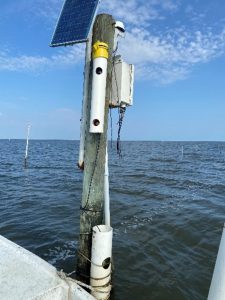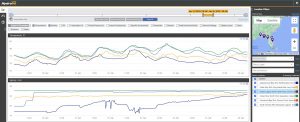The water quality monitoring station at the Gulf Jackson Aquaculture  Use Zone (AUZ) in Cedar Key is up and running! Along with the Dog Island AUZ station, real-time information on water temperature, salinity, dissolved oxygen and pH is available for these leases and can be viewed at the Online Resource Guide for Florida Shellfish Aquaculture website by visiting the LIVE Water Quality pages.
Use Zone (AUZ) in Cedar Key is up and running! Along with the Dog Island AUZ station, real-time information on water temperature, salinity, dissolved oxygen and pH is available for these leases and can be viewed at the Online Resource Guide for Florida Shellfish Aquaculture website by visiting the LIVE Water Quality pages.
History of Stations In 2002-3, monitoring equipment was originally installed at these lease areas and seven others in Florida with USDA funding. However, lack of continued funding resulted in most stations being dismantled ten years later. Since then, the UF/IFAS Shellfish Aquaculture Extension Program has maintained the stations off Cedar Key, which were the ones most frequently utilized. In 2020, maintenance of the Gulf Jackson station was suspended due to limited field activities following the UF COVID-19 Policy. Also in 2022, functionality of the equipment was affected by discontinuation of the 3G cellular network.
 Equipment Upgrades Ongoing maintenance and upgrades have been critical to ensuring continual operation as the stations endure harsh conditions of the saltwater environment, undergo normal wear and tear, and components become outdated. In 2022, UF began required upgrades to both stations using In-Situ equipment. The AquaTroll multiparameter sondes measure parameters every half hour and are posted to a website dashboard every 2-4 hours. Data are error-corrected, graphed, and provided monthly at the Archived Water Quality Information web page (Dog Island, Gulf Jackson). The stations undergo regular maintenance by UF staff.
Equipment Upgrades Ongoing maintenance and upgrades have been critical to ensuring continual operation as the stations endure harsh conditions of the saltwater environment, undergo normal wear and tear, and components become outdated. In 2022, UF began required upgrades to both stations using In-Situ equipment. The AquaTroll multiparameter sondes measure parameters every half hour and are posted to a website dashboard every 2-4 hours. Data are error-corrected, graphed, and provided monthly at the Archived Water Quality Information web page (Dog Island, Gulf Jackson). The stations undergo regular maintenance by UF staff.
Expansion of Stations This year, the Oyster FARMS Network was formed to increase oyster mortality monitoring efforts across the state. In-situ AquaTroll dataloggers were deployed inside oyster bags at farms located in eight Shellfish Harvesting Areas to monitor temperature and salinity. Growers maintain loggers and download data via Bluetooth to a mobile app, which is sent to UF staff and posted to the website dashboard. Archived data are error-corrected and provided as monthly graphs here.
formed to increase oyster mortality monitoring efforts across the state. In-situ AquaTroll dataloggers were deployed inside oyster bags at farms located in eight Shellfish Harvesting Areas to monitor temperature and salinity. Growers maintain loggers and download data via Bluetooth to a mobile app, which is sent to UF staff and posted to the website dashboard. Archived data are error-corrected and provided as monthly graphs here.
For clam and oyster growers, salinity levels at lease areas are probably the most useful information provided by these stations. This information allows growers to make more informed decisions on when to plant, transfer, or harvest shellfish. Predictions for an El Ninõ to form are high (90% chance) for the 2023-24 winter. Flood predictions and river discharge information provided by the National Weather Service can be viewed here. To view the Suwannee River discharge and gage height go to the USGS gage near Wilcox. To learn more about the role of salinity in hard clam production, view the UF/IFAS publication here.



